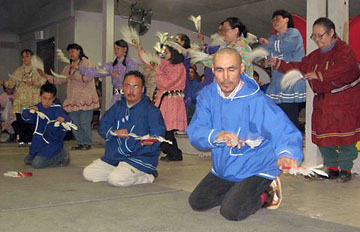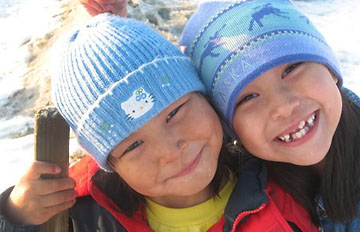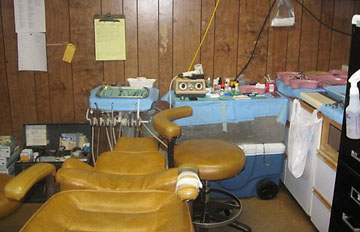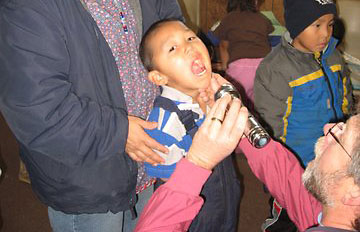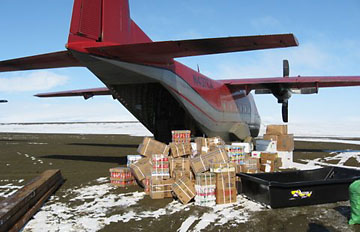home | internet service | web design | business directory | bulletin board | advertise | events calendar | contact | weather | cams

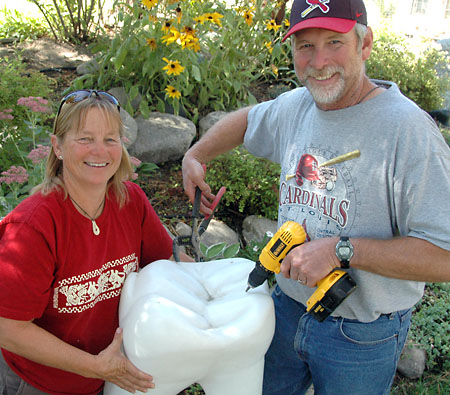 Jill and Don Calvert joke with a tooth stool and some ‘dental equipment’ at their home above the Chewuch River. Jill and Don Calvert joke with a tooth stool and some ‘dental equipment’ at their home above the Chewuch River.
Bush Dentists Don and Jill Calvert have been traveling to Alaska for 29 years to do “bush dentistry”. Jill is headed out next, departing this week for two weeks. That leaves Don home with their son, Riley, and a Chinese exchange student named Muzhi Na (who has taken the name ‘David’ while he is here) in their pleasant home on the Chewuch River. Riley is 16. David is 17, exactly one year older. They share a birthday. For the first 12 years of Riley’s life, the family went north together for about five weeks of the year. When Riley was very young and both parents were working, he was tended by a ‘grandmotherly type’ Native in the villages they traveled to, explained Jill. His Alaska name was ‘Ickpuk “ which means ‘big eyes’. Villagers also jokingly called him ‘the no-smell baby’, Jill laughed. After a day with the babysitter eating village foods such as dried fish and seal oil and hanging around on animal furs, Riley would have a definite aroma, Jill said and he would come back and get a bath. The villagers found it humorous, and nick-named the baby. Riley went to preschool, kindergarten and public school in both Alaska and Washington through the sixth grade. But the travel started to interfere with his schooling, his parents said, so they started keeping him home in the Methow Valley beginning in seventh grade, and traveling one parent at a time.  Jill Calvert, in a photo taken some time back, sits at an Alaskan airstrip on the sled with its 1,000 pounds of dental equipment and supplies. Jill Calvert, in a photo taken some time back, sits at an Alaskan airstrip on the sled with its 1,000 pounds of dental equipment and supplies.
“We met in dental school at the U of W,” explained Don. Following graduation, a phone call 29 years ago to Public Health Services in Alaska led to an interview by a rather uncommunicative Alaskan, John White. He came to the lower 48 - wearing fishing boots and a rag wool sweater - to interview the Calverts. They met at a Seattle Phinney Ridge restaurant. What did he want to eat? “I’m into bulk,” White said. That interview lead to work taken ‘sight unseen’ and ‘pay unknown’ which eventually evolved into steady jobs for both of them as dentists traveling into the remote reaches of the Alaskan bush, fixing teeth. Bethel, population around 6,000 people, was and still is the center of their work. Don said when he first stepped off the plane into Bethel on the Yukon-Kuskokwim delta, he thought ‘where’s Alaska?’. It was flat, flat, flat, flat. What’s jokingly called the Bethel National Forest is a single spruce tree in town. The town had no pavement and most people moved around by four-wheelers. Water was hauled to each house via truck and stored in tanks. “Greywater was removed by hopefully a different truck than the delivery truck.” Jill laughed. Well, the Calverts “wanted adventures,” Jill said. And they got it. Traveling to and from the remote places was a job in itself.
“Give us water, electricity and space and we were doing dentistry,” Jill said. “Our goal was to make sure every kid would graduate with teeth intact.” Because they both have ‘Dr.’ in front of their names, people expected them to help with more than teeth: a lot of wild things came their way. They helped as they could, taking on what they were able to handle and stabilizing the big traumas for transportation to clinics and hospitals. They dealt with gunshot wounds to the head and the belly, handled alcohol related traumas, sutured wounds, delivered a baby, and saved a life with CPR. Amenities were skeletal: water was usually from ice gathered out of the river and melting in a garbage can. The toilet was most often a honey bucket. 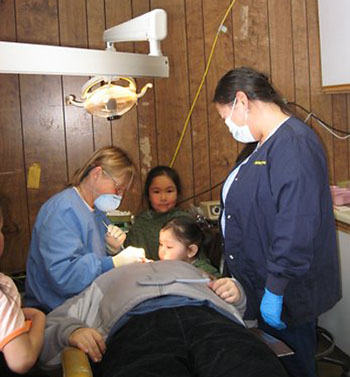 Dentistry is a family affair: Jill works on a patient while family members look on. Dentistry is a family affair: Jill works on a patient while family members look on.
Don and Jill fixed teeth about 18 hours per day for five to ten days, then they would start the pack-transport-unpack sequence backwards. They don’t do that so much anymore. Alaska now boasts five fancy sub-regional multi-million dollar clinics with acute care rooms, one to two physicians assistants on staff, a mental health worker, dentist, lab and radiology services and an office manager. The home base clinic is in Bethel, served by eight to ten dentists from all over the country. The Yukon Kuskokwim service area is the size of Oregon, and holds about fifty villages with a population of about 25,000. “Care is totally free to the Yupik Eskimo patients,” said Jill. “The job has changed,” said Don. “It's way more civil in the bush”. Don and Jill each now spend about 10 weeks out of the year in Alaska, traveling alternately for two or three weeks at a time. They work hard, 12 to 13 hours per day, with no off days. “Now we’re hired guns,” said Jill. They just pack their bags and personal stuff and go. The equipment and supplies are provided, and they have assistants. Over the years, a community health aide program has trained people in the villages. “These people are very good at making common diagnosis and they communicate daily with a physician,” said Don. They are well-trained in emergency medicine and common ailments. What about the Calverts’ goal to make sure every kid would graduate with teeth intact? Teeth aren’t doing so well in the far north, they said. They used to see elders with all their original teeth - teeth worn flat with heavy use. But now, they said, it’s extremely rare to see anyone 55 years or younger with a full set of teeth. “It’s all diet related,” said Don. Soda pop and sugar and carbohydrates are now staples of the local diet, and it shows in a bad way to a dentist. “General health has declined,” he said. They work on appallingly bad teeth in very young children. Eighty percent of children under the age of five have been to the operating room, under general anesthesia, and received comprehensive dental care. When they pack to leave the Methow for Alaska, the Calverts include their own food, since food costs three to four times more in the far north than it does here. And they both lean towards easy, instant meals because they work long hard hours and they are too tired to cook much in the evenings.
9/19/2012 Comments
|
||||||||||||||

